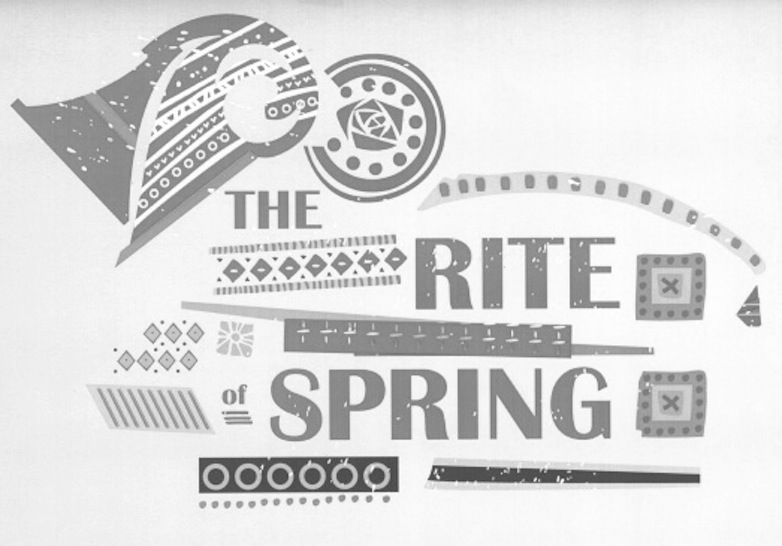Assistant Opinion & Editorial Editor
Lynn Matluck Brooks, the Arthur and Katherine Shadek professor of Humanities and Dance, served as moderator for The Rite of Spring — Choreography on Film and Live at Millersville University’s Ware Center in F&M’s kick-off celebration of the prolific ballet’s centennial on Wednesday.
Sponsored in equal parts by Millersville University’s Ware Center, Shenandoah University, and F&M’s Committee for the Centennial of The Rite of Spring, the event featured remarks from Brooks, film excerpts from three of Rite’s numerous interpretations, and Red Dress, a new choreography of The Rite of Spring performed live by Shenandoah University’s Flying Lions Dance Company.
The performance was then followed by an interactive talk-back featuring the Company’s dancers, Red’s choreographer, Ting-Yu Chen, Brooks, and Lina Bernstein, professor of Russian.
Brooks spoke to the origins of The Rite of Spring in her opening remarks at the event.
“The story was a pagan tribe in the steppes of Russia that needs to awaken the Earth in spring by sacrificing a maiden,” she stated. “The entire story is about this, this pagan ritual, the choices they make, and her dancing herself to death, which we see in the course of [choreographer Vaslav] Nijinsky’s choreography.”
If this premise seems to smack with just a bit of morbidity, then, as Brooks explained, Rite’s composer, Igor Stravinksy, achieved his goal.
“Both Stravinsky’s music and Nijinsky’s choreography were part of a radical new envisioning of expression in their respective arts,” Brooks said. “In a sense, they precipitated the birth of modernism in music and dance.”
The expression modernism, as Bernstein explained, casts a wide net around a massive cultural force of the early 20th century.
“[It] is a term used to describe a number of developments in the arts and literature around the turn of the 20th century that reflected the increasing industrialization and urbanization in the West,” Bernstein said.
“[Modernism] reject[ed] both the certainties of the Enlightenment and the idealized emotionalism of Romanticism, and embrac[ed] abstraction in art, dissonance in music, and primitivism as a source of
inspiration.”
What makes The Rite of Spring so distinguished, then, as Bernstein noted, is its decidedly enthusiastic embrace of the unconventional.
“All of these aspects are reflected in the music, scenery, costumes, and choreography of The Rite of Spring,” Bernstein said. “[It] stands as one of the great monuments of modernism.”
Brooks, too, was struck by the anti-aesthetic of Stravinsky’s avant garde work.
“What is interesting to me is that the vision for Rite was rooted in the artists’ concepts of ‘primitivism’ — an ancient, pagan Russian fertility rite of sacrificing a maiden to the earth to initiate Spring: music of a highly percussive and relentless nature; movement that reached back to what Nijinsky regarded as pre-balletic, pre-codified positions, steps, and qualities.”
In an ironic twist, as Brooks herself noted, “‘Primitivism’ birthed modernism.”
The Rite of Spring, it is plain, attempted to make that birth as jarring as possible. Brooks referenced a letter sent to Stravinsky from Nijinksy in her opening remarks that made the revolutionary goals of the two clear.
“‘Now I know what The Rite of Spring will be when everything is as we both want it: New, beautiful, and utterly different,’” Brooks quoted. “‘But for the ordinary viewer, jolting and emotional experience.’”
“Jolting and emotional,” indeed, could accurately encapsulate The Rite of Spring’s initial reception; part of what has made Stravinsky’s ballet so prominent is its historically, extraordinarily negative greeting upon its premiere.
Its audience launched an all-out riot at the ballet’s first show, so unsettled were they by its bucking of ballet’s rules.
“From its first note, this work’s premiere stimulated fights, cat-calls, and pandemonium in the theater, before the curtain even rose, just a musical prelude,” Brooks said.
Once the stage was revealed, with the dancers in their ballistic, turned-in movement and brilliantly (and strangely) colored costumes, the spectators went wild. I wish audiences took art as seriously today!”
The Committee for the Centennial of The Rite of Spring is also planning a number of other events in order to commemorate that riotous, momentous night 100 years ago.
On Saturday, the F&M Philharmonia, joined by community musicians, performed selections from The Rite of Spring’s score.
On March 4, the Phillips Museum of Art will host a lecture by archivist Gene Gaddis about the Ballet Russes, or, the Russian Ballet, while the film Coco Chanel and Igor Stravinsky will be screened in the Brooks House Great Room.
The Phillips Museum of Art will also be hosting a series of photographic and digital images that seek to capture the significance of the ballet from March 4 through March 25, and Brooks House Great Room, additionally, will be featuring a lecture by renowned dance historian Lynn Garafola on March 7.
Questions? Email Erin at emoyer1@fandm.edu.
